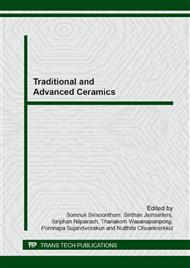[1]
P. Lada and W. Pimpawan, Effect of additives on properties of used cermic plaster mould, 16th Annual International Sustainable Development Research Conference (2010), Information on http: /www. kadinst. hku. hk.
Google Scholar
[2]
A. Bentur, K. Kovler, A. Goldman, Gypsum of improved performance using blends with Portland cement and silica fume, Adv. Cem. Res. 6 (1994) 109-116.
DOI: 10.1680/adcr.1994.6.23.109
Google Scholar
[3]
K. Kovler, Strength and water absorption for gypsum-cement-silica fume blends of improved performance, Adv. Cem. Res. 10 (1998) 81-92.
DOI: 10.1680/adcr.1998.10.2.81
Google Scholar
[4]
R.X. Magallanes-Rivera, C.A. Juarez-Alvarado, P. Valdez, J.M. Mendoza-Rangel, Modified gypsum compounds: An ecological-economical choice to improve traditional plasters, Constr. Build. Mater. 37 (2012) 591-596.
DOI: 10.1016/j.conbuildmat.2012.07.054
Google Scholar
[5]
K. Sobolev, P. Türker, S. Soboleva, G. Iscioglu, Utilization of waste glass in ECO-cement: Strength properties and microstructural observations , Waste Manage. 27 (2007) 971-976.
DOI: 10.1016/j.wasman.2006.07.014
Google Scholar
[6]
C. Shi, K. Zheng, A review on the use of waste glasses in the production of cement and concrete, Resour. Conserv. Recycl. 52 (2007) 234-247.
Google Scholar
[7]
C. Shi, Y. Wu, C. Riefler, H. Wang, Characteristics and pozzolanic reactivity of glass powders, Cem. Concr. Res. 35 (2005) 987-993.
DOI: 10.1016/j.cemconres.2004.05.015
Google Scholar
[8]
J. Péra, J. Ambroise, T. Kuryatnyk, Development of insoluble gypsum using calcium sulfoaluminate cement, Constr. Build. Mater. 10 (2007) 37-43.
Google Scholar
[9]
ASTM Standard C618, 2001, Specification for Coal Fly Ash and Raw or Calcined Natural Pozzalan for use as a Mineral Admixture in Concreate, ASTM International, West Conshohocken, PA, 2001, DOI: 10. 1520/C0618-00, www. astm. org.
Google Scholar
[10]
K. Tounchuen, P. Umponpanarat, W. Buggakupta, W. Panpa, Effect of diatomite and glass cullet in the waste-based gypsum building materials, Key Eng. Mater. 545 (2013) 122-128.
DOI: 10.4028/www.scientific.net/kem.545.122
Google Scholar
[11]
L. Coppola, G. Belz, G. Dinelli, M. Collepardi, Prefabricated building elements based on FGD gypsum and ashes from coal-fired electric generating plants, Mater. Struct. 29 (1996) 305-311.
DOI: 10.1007/bf02486365
Google Scholar
[12]
M. Singh, M. Garg, Prefabricated building elements based on FGD gypsum and ashes from coal-fired electric generating plants, Constr. Build. Mater. 6 (1992) 52-56.
DOI: 10.1007/bf02486365
Google Scholar
[13]
Q. Zhang, F. Saito, Sonochemical synthesis of ettringite from a powder mixture suspened in water, Powder Technol. 107 (2000) 43-47.
DOI: 10.1016/s0032-5910(99)00086-8
Google Scholar
[14]
M. Tanaka and G. Hashizume, H. Matsui and S. Nakagawa, U.S. Patent 4, 255, 398. (1981).
Google Scholar
[15]
M. Garg, N. Jain, Waste gypsum intermediate dye industries for production of building matrerials, Constr. Build. Mater. 24 (2010) 1632-1637.
DOI: 10.1016/j.conbuildmat.2010.02.029
Google Scholar


